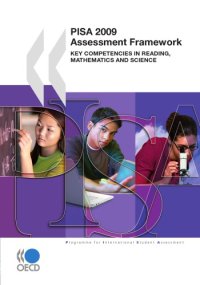- Tags: Comparative Analysis, Educational Policy, Student Attitudes, Skill Development, Computer Literacy, Educational Environment, Cognitive Style, Background, Questionnaires, Secondary School Students, Science Achievement, Student Evaluation, Reading Achievement, Mathematics Achievement, Educational Assessment, Elementary Secondary Education, Academic Achievement, Foreign Countries, Outcomes of Education, Familiarity, Evidence
- Year: 2009
- Publisher: OECD
- Language: English
-
pdf
In response to the need for cross-nationally comparable evidence on student performance, the Organisation for Economic Co-operation and Development (oecd) launched the oecd Programme for International Student Assessment (pisa) in 1997. pisa represents a commitment by governments to monitor the outcomes of education systems through measuring student achievement on a regular basis and within an internationally agreed common framework. It aims to provide a new basis for policy dialogue and for collaboration in defining and implementing educational goals, in innovative ways that reflect judgments about the skills that are relevant to adult life. Pisa is a collaborative effort undertaken by its participants--the oecd member countries as well as over 30 non-member partner economies--to measure how well students, at age 15, are prepared to meet the challenges they may encounter in future life. Pisa is designed to collect information through three-yearly assessments and presents data on domain-specific knowledge and skills in "reading", "mathematics" and "science" of students, schools and countries. It combines the assessment of science, mathematics and reading with information on students' home background, their approaches to learning, their learning environments and their familiarity with computers. Student outcomes are then associated with these background factors. Thereby, pisa provides insights into the factors that influence the development of skills and attitudes at home and at school, and examines how these factors interact and what the implications are for policy development. This publication presents the theory underlying the pisa 2009 assessment, including a re-developed and expanded framework for "reading literacy", which incorporates an innovative component on the capacity to read and understand electronic texts, thus reflecting the importance of information and computer technologies in modern societies. It also provides the basis for the assessment of mathematics and science. Within each domain, the knowledge content that students need to acquire is defined, as well as the processes that need to be performed and the contexts in which knowledge and skills are applied. It also illustrates the domains and their aspects with sample tasks. Finally, the theory underlying the context questionnaires is presented. These are used to gather information from students, schools and parents on the students' home background and attitudes, their learning histories and their learning environments at school. Annexes include: (1) Print reading sample tasks; (2) Electronic reading sample tasks; (3) Background questionnaires; and (4) pisa expert groups. Individual chapters contain references and notes. (Contains 2 boxes, 18 tables and 28 figures.). Read more...
